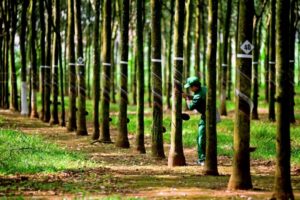Eight hundred hectares of rubber trees infected with fungal disease in the Philippines
Zamboanga City, the Philippines – At least 800 hectares of rubber trees have been infested by the Pestalotiopsis disease in Basilan, a rubber producing province.
Basilan Gov. Hadjiman Hataman-Salliman said Thursday said the Pestalotiopsis attack was noticed by farmers in the fourth quarter of last year.
Salliman believed that the Pestalotipsis disease may have originated from the nearby state of Sabah, Malaysia. He did not elaborate.
“I already directed the Provincial Agriculture Office to conduct a study on the possible treatment of the rubber disease in coordination with experts from the Philippine Rubber Research Institute,” he said.
The provincial government has adopted preventive protocols on rubber plantations, particularly the temporary prohibition to sag rubber trees and to fertilize them as initial preventive measure against the spread of the disease.
Pestalotiopsis palmarum is the causative agent of a fungal disease of bananas, coconut and Date palms. It attacks all parts of the leaf from the base to the tip.
Lamitan City Mayor Roderick Furigay said the Pestalotiopsis microspora infestation on rubber trees continues to spread, “now damaging about 60 to 70 percent of the rubber plantations in Lamitan City alone.”
Lamitan City OIC-City Agriculturist Esther Domingo reported to Furigay that they found out during their inspection most rubber trees suffered from falling leaves or wintering period as a result of the Pestalotiopsis attack.
Domingo explained that the wintering period of rubber trees was abnormal, not only it causes the leaves to fall it also reduces the rubber tree sap production.
The province of Basilan is the third top rubber producing province in the country. In 2021, Basilan recorded 76,433 metric tons of coagulated cum lump produced.
The top rubber producing country in the country is North Cotabato followed second by Zamboanga Sibugay.

